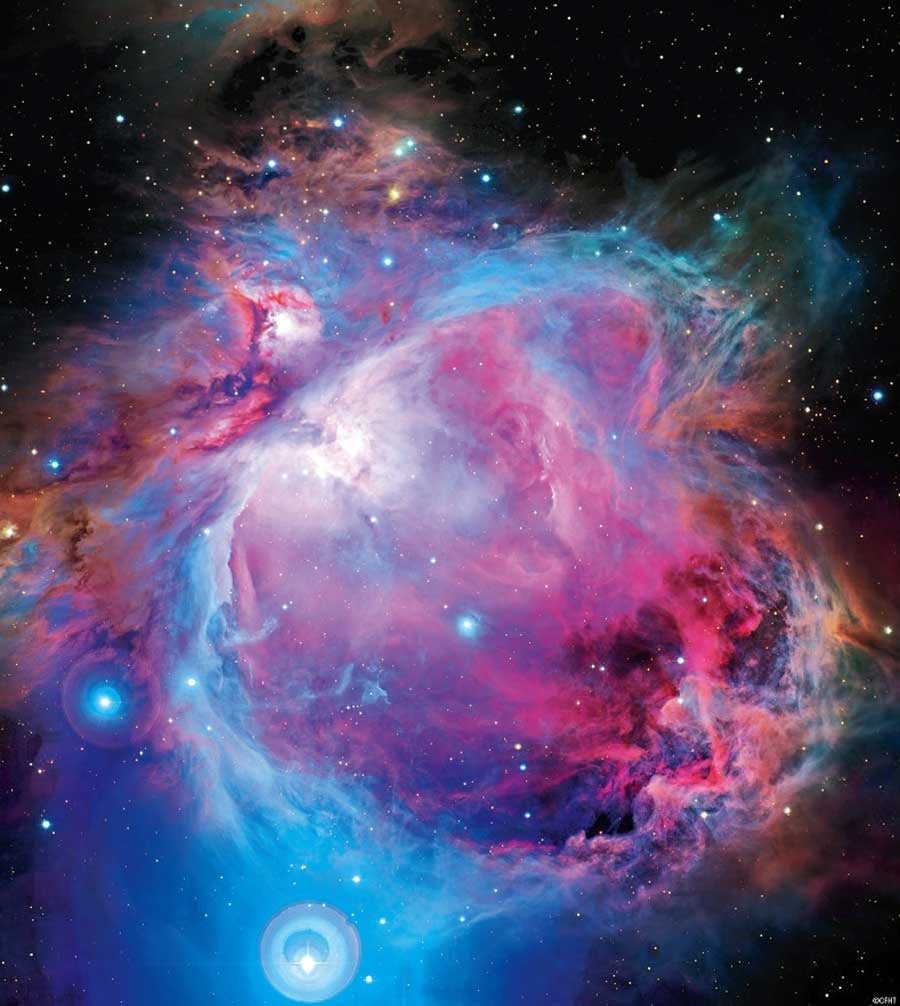The Orion Nebula reveals many of its hidden secrets in a dramatic image taken by the new United Kingdom-designed Visible and Infrared Survey Telescope for Astronomy (VISTA). The survey telescope’s huge field of view can show the full splendor of the whole nebula, and VISTA’s infrared vision also allows it to peer deeply into dusty regions that are normally hidden and expose the curious behavior of the very active young stars buried there.
VISTA is the latest addition to the European Southern Observatory’s (ESO) Paranal Observatory in Chile. It is the world’s largest survey telescope, and it maps the sky at infrared wavelengths. The 4.1-meter mirror, wide field of view, and sensitive detectors make VISTA unique. This dramatic new image of the Orion Nebula illustrates VISTA’s remarkable powers.
The Orion Nebula is a vast stellar nursery lying about 1,350 light-years from Earth. Although the nebula is spectacular when seen through an ordinary telescope, what can be seen using visible light is only a small part of a cloud of gas in which stars are forming. Most of the action is deeply embedded in dust clouds, and to see what is really happening, astronomers need to use telescopes with detectors sensitive to the longer wavelength radiation that can penetrate the dust. VISTA has imaged the Orion Nebula at wavelengths about twice as long as can be detected by the human eye.
“When I started in infrared astronomy, we had to collect data with 1 pixel cameras,” said Jim Emerson, leader of the VISTA consortium from Queen Mary University of London. “The United Kingdom expertise that designed and built VISTA now enables one to acquire images like this with 100s of millions of pixels. It’s amazing how much this will push forward the frontiers of our knowledge of star formation.”
“It is hugely rewarding to see the fantastic new science that VISTA is now producing,” said Ian Robson, director of the Science & Technology Facilities Council’s (STFC) UK Astronomy Technology Center (ATC) who were in charge of building the VISTA facility. “This capability for deep survey studies will enable astronomers to understand better the evolution of the universe and the building blocks of the galaxies and stars within it.”
As in the many visible light pictures of this object, the new wide field VISTA image shows the familiar bat-like form of the nebula in the center of the picture as well as the fascinating surrounding area. At the very heart of this region lie the four bright stars forming the Trapezium, a group of hot, young stars pumping out fierce ultraviolet radiation that is clearing the surrounding region and making the gas glow. However, observing in the infrared allows VISTA to reveal many other young stars in this central region that cannot be seen in visible light.
Looking to the region above the center of the picture, curious red features appear that are completely invisible except in the infrared. Many of these are very young stars that are still growing and are seen through the dusty clouds from which 435,000 miles (700,000 kilometers) per hour, and many of the red features highlight the places where these gas streams collide with the surrounding gas, causing emission from excited molecules and atoms in the gas. There are also a few faint, red features below the Orion Nebula in the image, showing that stars form there too, but with much less vigor. These strange features are of great interest to astronomers studying the birth and youth of stars.
“On the one hand, the panoramic infrared overview given by VISTA’s wide field of view shows the relationships between the young stars and the gas and dust they were born from, and on the other hand, VISTA’s exquisite detail and sensitivity allows finding even very faint young stars,” said Emerson.
This new image shows the power of the VISTA telescope to image wide areas of sky quickly and deeply in the near-infrared part of the spectrum. The telescope is just starting to survey the sky and astronomers are anticipating a rich harvest of science from this unique ESO facility.










